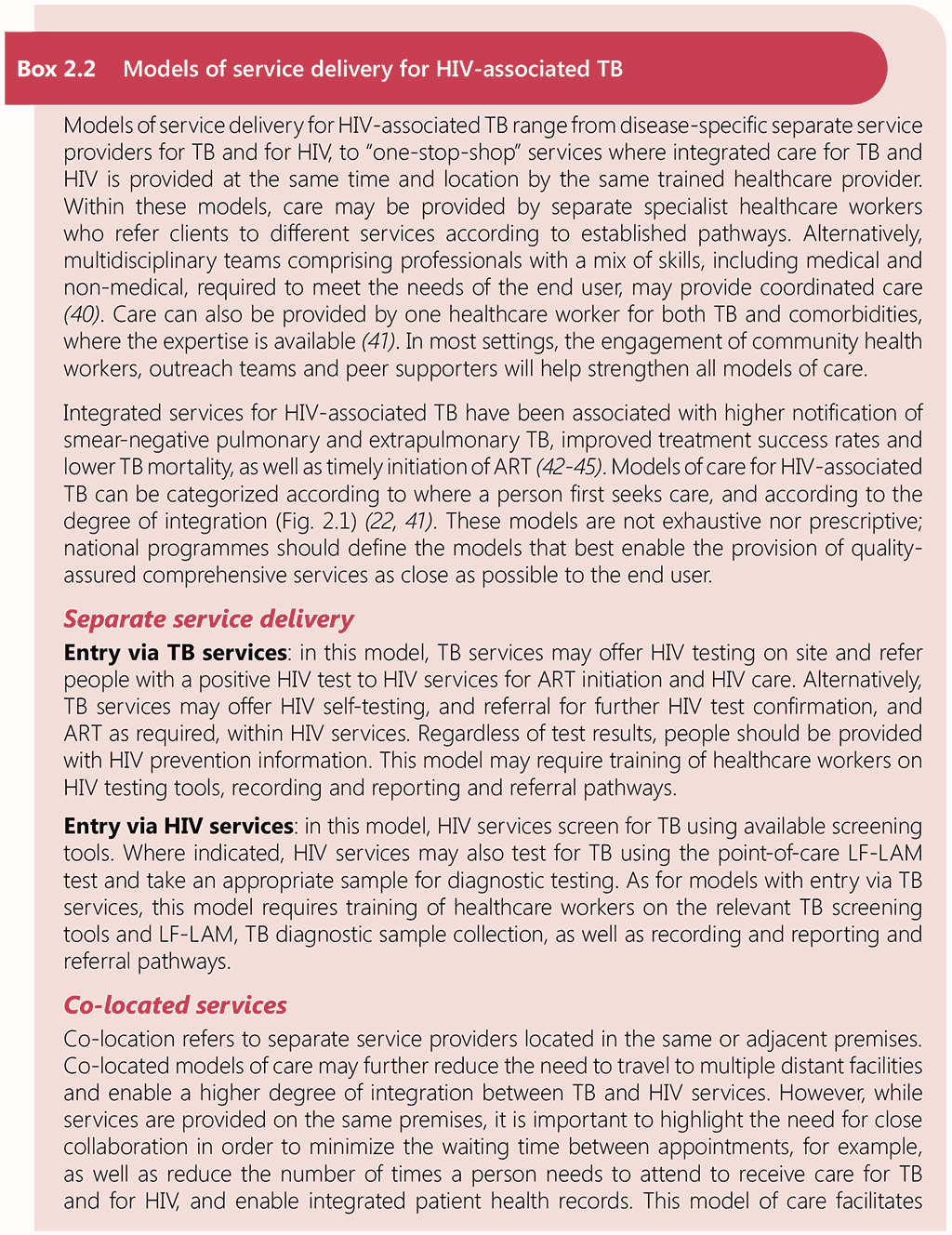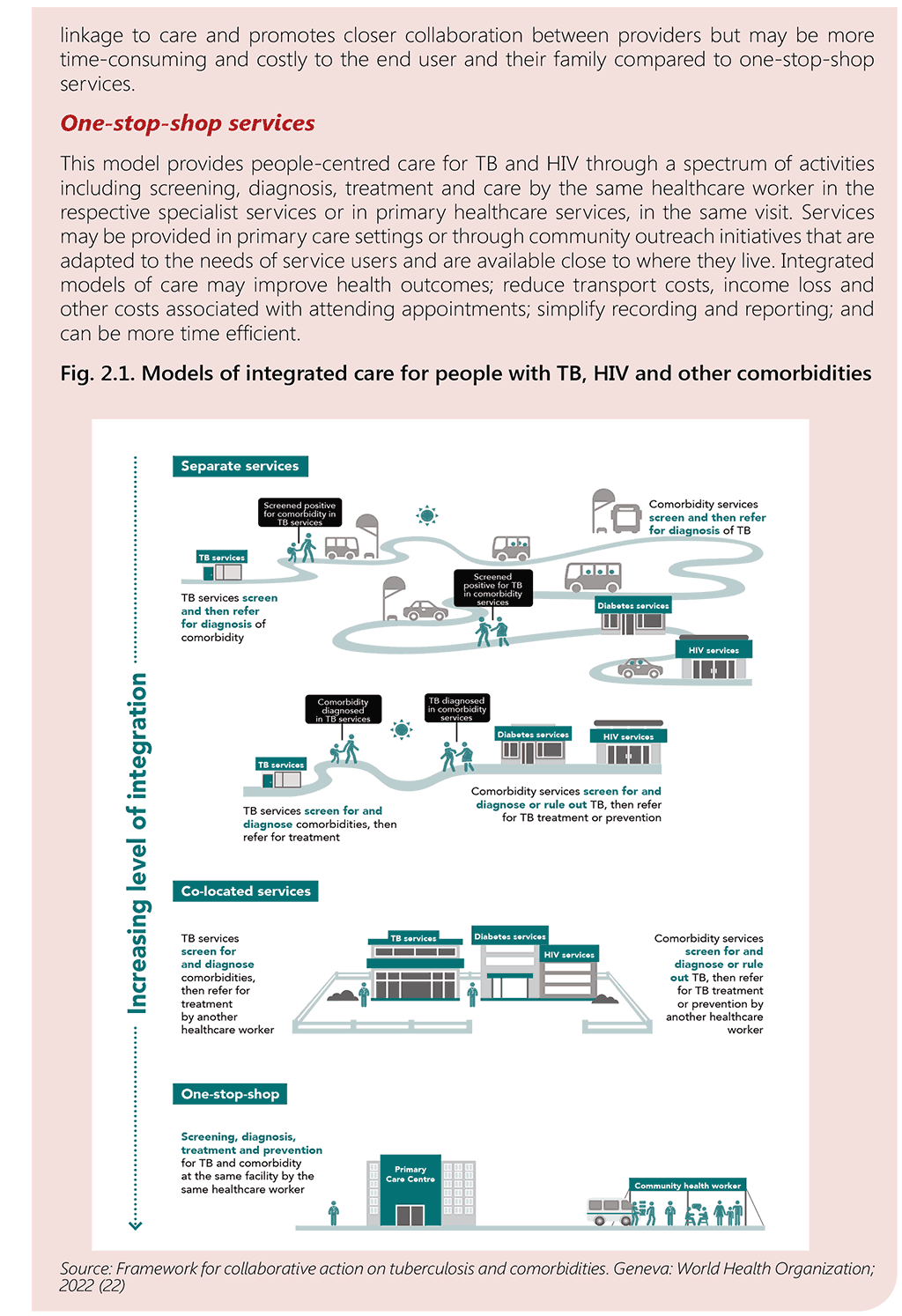كتاب روابط اجتياز لـ 1266

2.3.1 Identify priority comorbidities and interventions
WHO has recommended collaborative TB/HIV activities in all contexts since 2004 and as such, HIV should be a prioritized TB comorbidity for all countries. Collaborative TB/HIV activities have been scaled up in most high TB/HIV burden settings. However, there will likely be gaps in access and quality across the cascade of care.
As part of the planning process, countries should identify priority gaps and related interventions to scale up and strengthen access to TB/HIV services, based on the analysis of access to quality services for TB and HIV, which should also include other comorbidities. Criteria for prioritization should be agreed using the coordination platform or related technical working group. The criteria for prioritization may include, but should not be limited to, the causes and distribution of morbidity and mortality, cost implications, ethical, equity and human rights considerations and acceptability. During the data review, another comorbidity such as undernutrition may be identified as important among people dying from TB and HIV, and so priority may be given to assessment of and management of undernutrition in all people with TB and HIV.
Some countries have a concentrated HIV epidemic and a high burden of TB, with a limited coverage of collaborative TB/HIV activities. In such a context they should prioritize, in the short term, activities to reduce the burden of TB among people with HIV (TB screening, TB preventive treatment, diagnosis, treatment and care) among all people attending HIV care. In parallel, HIV testing and ART within TB services may be scaled up strategically starting with urban centres, high HIV burden provinces or populations more at risk of HIV.
2.3.2 Define and reorient models of care for HIV-associated TB and other comorbidities towards people-centred services, primary health care and universal health coverage
Where feasible, programmes should aspire to decentralize and integrate services for TB and HIV down to the primary care and community levels, so that people with HIV-associated TB can access care on an ambulatory basis where possible (34). Services for TB and HIV should be tailored to the needs and preferences of affected persons and should aim to minimize the time and financial costs incurred while accessing care. To this end, programmes should work together to shape models of care and social protection that assure the provision of integrated services, preferably at the same time and location, and as close as possible to people who need them. Integrated models of care are feasible, acceptable, cost-effective and may have high rates of TB treatment success (35-39). A concern with any model of integration is the risk of nosocomial spread of TB. Thus, implementation of proper infection prevention and control measures (see Chapter 3.5) is crucial throughout health facilities in high burden settings to minimize the risk of nosocomial spread of TB to immunosuppressed people living with HIV. On the other hand, integrated care supports early detection and treatment of undiagnosed infectious TB and may result in a reduction of TB risk compared with separate services. Box 2.2 and Fig. 2.1 describe models of service delivery for TB, HIV and other comorbidities, according to where a person first seeks care, and according to the degree of integration (22).


2.3.3 Conduct collaborative planning and budgeting to scale up people-centred services for TB and HIV
Joint planning and budgeting for integrated services may contribute to efficiency of resource use and improved health outcomes. To ensure sustainability, planning should be harmonized with the country’s national health strategic plans, health system-strengthening agenda and overall efforts towards achieving universal health coverage (UHC) and social protection. Key areas for joint planning include quality-assured health services; health workforce; information systems and sharing of data with relevant agencies; equitable access to essential medicines, vaccines and technologies; health financing and social protection; and leadership and governance. Joint proposals should be prepared for mobilizing domestic and external resources for collaborative TB/HIV activities. These should be prepared within the framework of the joint coordinating body, building on the comparative strengths of both programmes and the specific needs of the country. Alternatively, both HIV and TB funding proposals should include resources to address collaborative TB/HIV activities in each proposal with clear division of labour to avoid duplication of efforts (7).
2.3.4 Align advocacy and communication across health programmes
Advocacy targeted at influencing policy, programme implementation, and resource and community mobilization is important to accelerate implementation of collaborative TB/HIV activities at all levels. Two-way communication between the programmes and the public and with affected populations, can inform and create awareness about both diseases and is crucial for ensuring that people actively seek and demand services. Effective communication measures focus on communities rather than individuals and combine a series of elements from the use of data, science, research, policy and advocacy. This can inform the public, shape perceptions and attitudes, mitigate stigma and enhance the protection of human rights. It can also create demand for services, form stronger links with health services and systems, and improve provider–client relationships. Joint communication strategies for HIV-associated TB should ensure the mainstreaming of HIV messaging in TB communications and of TB messaging in HIV communications (7).

 تعليق
تعليق